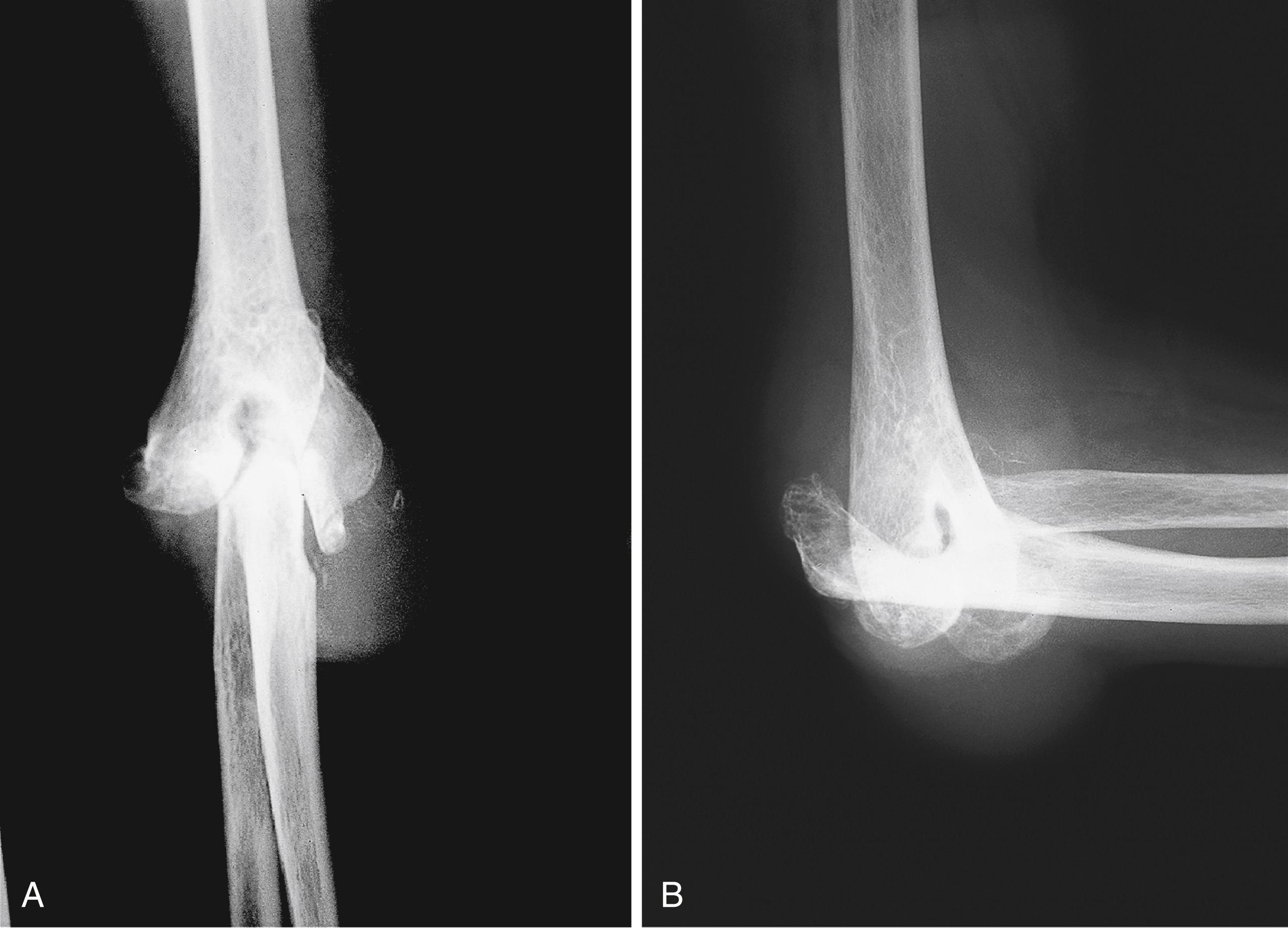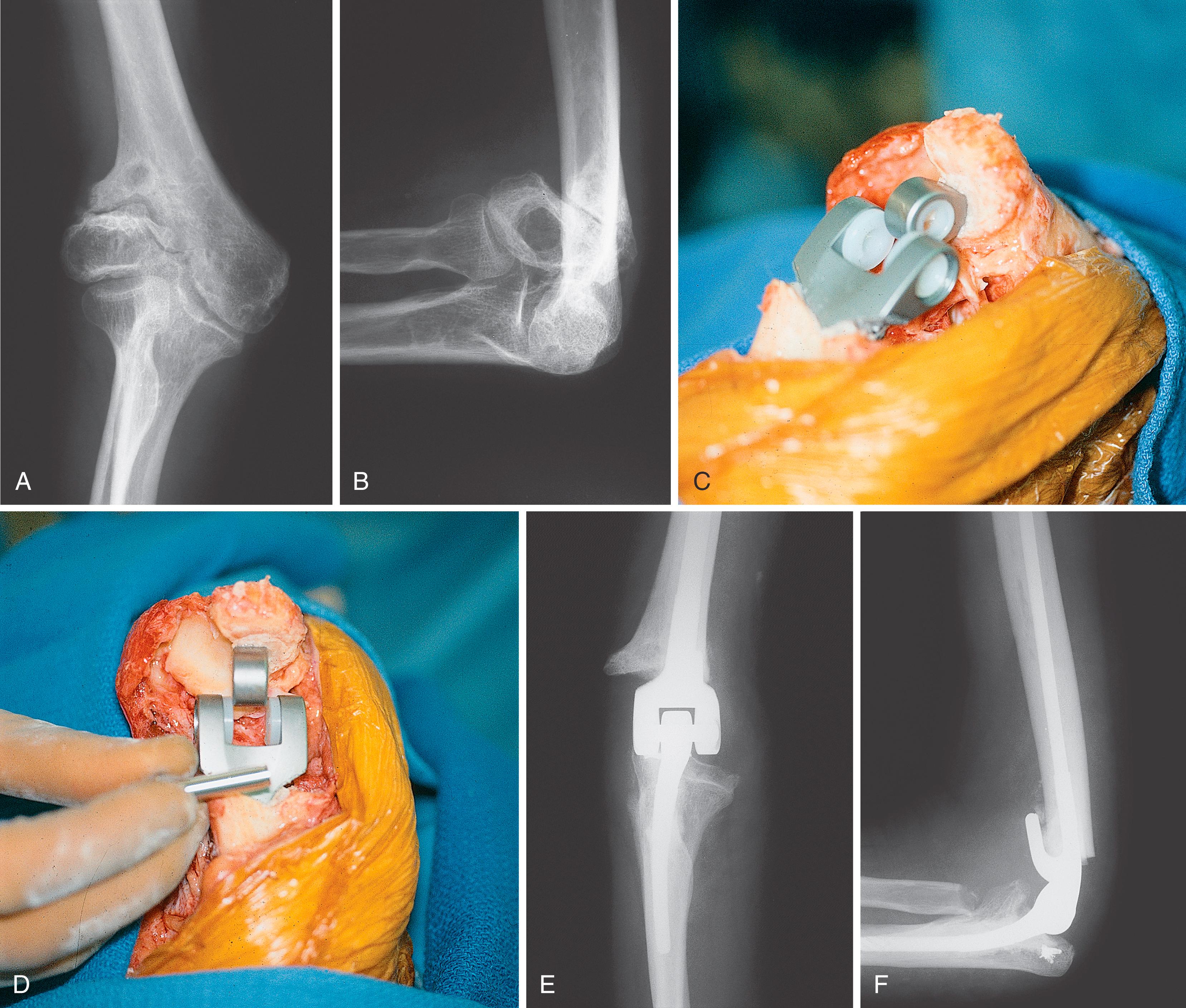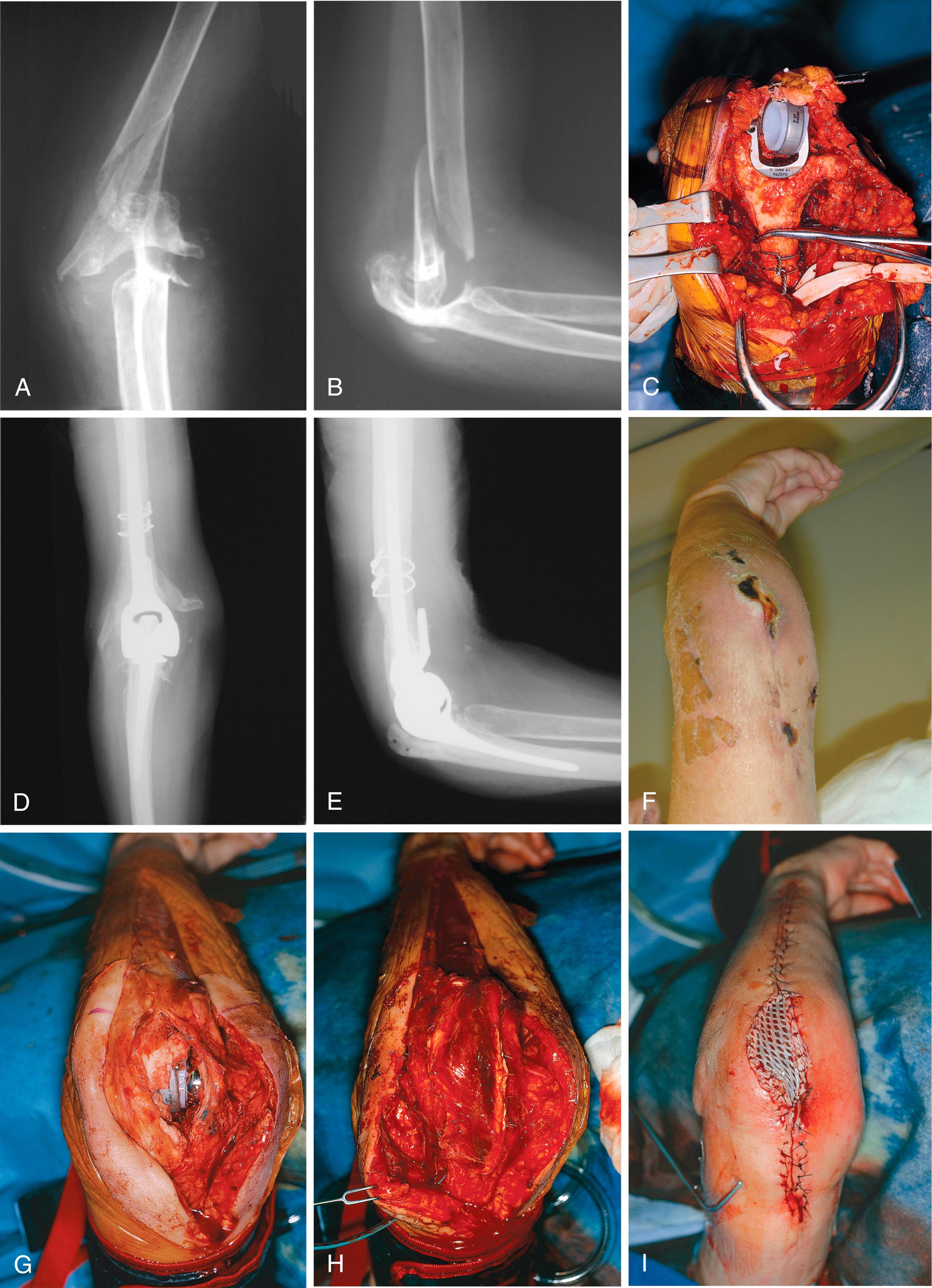Physical Address
304 North Cardinal St.
Dorchester Center, MA 02124
Acknowledgments: We would like to acknowledge prior author Leonid Katolik, MD, for his contributions to earlier editions and his insights in developing the current text.
Total elbow arthroplasty (TEA) is used for the treatment of debilitating elbow arthropathies. Although clinical outcomes following TEA were initially disappointing, modifications in surgical technique and implant design have improved reliability; however, durability with normal loading (>10 pounds) is still a challenge. Prosthetic replacement of the elbow relieves pain and typically provides a functional arc of motion, thereby permitting patients to better perform low-load activities of daily living. Unfortunately, the longevity of implants in patients younger than 70 years is often short, and revision options are limited. Long-term follow-up studies report high rates of revision relative to arthroplasties of the hip, knee, and shoulder. , Because of the high potential for mechanical failure and loosening, this procedure should be limited to low-demand older patients or those terribly debilitated by pain and instability. It is hoped that improvements in materials, implant design, and surgical technique will one day extend the suitability of TEA to a wider array of pathologic conditions and a broader demographic spectrum.
Elbow arthroplasty has evolved from attempts at resurfacing or replacing the distal humerus and/or ulna with various materials. Fully constrained TEA using a rigid hinge led to rapid failures because of loosening at the bone-implant interface. Attempts at distal humeral and proximal ulna resurfacing were commonly complicated by component failure. But these early designs evolved into the implants used currently ( Table 27.1 ).
| Device and Era | Year of Notable Development | Author | Significance |
|---|---|---|---|
| Hemiarthroplasty, 1920–2000s | 1952 | Venable | Metal distal humerus replacement |
| 1965 | Barr and Eaton | Vitallium replacement of distal humerus | |
| 1970 | Johnson and Schlein | Vitallium replacement of proximal ulna | |
| 1971 | Peterson and Janes | Vitallium ulnar “saddle” interposition; limited arc of motion; acceptable longevity | |
| 2011 | Burkhart et al. | Convertible hemiarthroplasty for distal humerus fracture | |
| Linked Arthroplasty, 1970–1980s | 1972 | Dee | Hinged total elbow arthroplasty: linked, rigid hinge |
| 1982 | Dee | Recognition that rigid hinge has high rate of implant loosening | |
| Surface Replacement Arthroplasty, 1970–1990s | 1984 | Rydholm et al. | Wadsworth prosthesis had high rates of humeral component loosening |
| 1990 | Kudo and Iwano | 70% of surface replacements had humeral subsidence | |
| Stemmed Unlinked Arthroplasty, 1970s–1990s | 1983 | Pritchard | Early experience with stemmed resurfacing arthroplasty of ulna, radius, and distal humerus |
| 1994 | Kudo et al. | Titanium-stemmed unlinked arthroplasty: failures observed at humeral stem junction | |
| 1999 | Trail et al. | Souter-Strathclyde unlinked arthroplasty: flanges into medial and lateral columns for added stability | |
| Stemmed Linked Arthroplasty, 1970–Present | 1977 | Schlein | Introduction of linked, semiconstrained prosthesis |
| 1982 | Morrey and Bryan | Recognition that linked, semiconstrained prosthesis has better survivorship than tightly constrained hinge | |
| 1992 | O’Driscoll et al. | Anterior flange limits stress on cement interface | |
| 2003 | Hastings | Spherical, linked semiconstrained articulation | |
| Convertible Unlinked to Linked Prosthesis | 2015 | Wagener et al. | Prosthetic design that can be converted from unlinked to linked, semiconstrained device |
Today there are two general types of implants for the arthritic elbow: linked and unlinked. An unlinked or nonconstrained prosthesis relies on adequate bony support and collateral ligaments for stability. This theoretically decreases loosening at the bone-cement interface but carries a greater risk of instability, especially in the rheumatoid population. These designs include the Kudo/Instrumented Bone Preserving (Biomet Europe), Souter-Strathclyde (Wright, Arlington, TN; Fig. 27.1 ), and Pritchard ERS (Depuy, Warsaw, IN). Many unlinked designs have been discontinued but may be encountered in the revision setting.

Linked designs involve stemmed implants with a semiconstrained articulation. Semiconstrained devices have the advantage over unlinked devices with respect to stability. However, even with several degrees of varus-valgus laxity, the most popular “sloppy” hinge mechanisms allow only a small area of contact between the humeral and ulnar components, leading to contact stresses of the polyethylene. Polyethylene wear of the bushings, osteolysis, and subsequent failure remain clinical problems. Commonly used semiconstrained designs include the Coonrad-Morrey (Zimmer, Warsaw, IN), the Discovery (DJO, Lewisville, TX), and Solar implants (Stryker, Mahwah, NJ).
In practice, reports of pain relief and functional gains appear to be similar for linked and unlinked designs, though that may be subject to selection bias. In an effort to improve on polyethylene wear, several new implants have been introduced. Some do not depend on a true hinge for stability and theoretically lead to decreased wear (Discovery, DJO, Lewisville, TX). Other prostheses have the capacity to be inserted in either a linked or an unlinked fashion (Latitude, Tornier, Saint-Ismier, France). Early data regarding these newer designs appear to have similar short-term clinical outcomes as earlier models, but radiographic loosening, especially of the radial component, is still a consideration.
Twenty percent of patients with rheumatoid arthritis have arthritic changes in the elbow. As with other major joints affected by rheumatoid arthritis, the elbow undergoes degeneration of the ulnohumeral and radiocapitellar articular surfaces, progressing to functional loss in advanced cases. Rheumatoid arthritis has been divided into four stages, based on the physical examination and plain radiographs. Stage I reveals osteoporosis and active synovitis with normal radiographs. Stage II demonstrates chronic synovitis with mild arthritic changes and some loss of joint space. In these early stages, arthroscopic synovectomy can be effective and seems to be more durable in combination with disease-modifying medications. However, regardless of treatment, some patients proceed to complete loss of cartilage with associated pain and loss of strength and mobility (stage III). The most severe form (stage IV) demonstrates extensive loss of bone and gross instability ( Fig. 27.2 ). It is this last group of patients that derives the greatest benefit from TEA.

Posttraumatic arthritis is an increasingly common indication for replacement arthroplasty. The treatment of posttraumatic arthritis must take into account the age and activity level of the patient, the degree of impairment, and the pathoanatomy of the joint. Given the lack of durability of TEA and the propensity for implant failure, techniques such as internal fixation for complex articular fractures, reconstruction of nonunions and malunions, joint release and debridement, and interposition arthroplasty should be considered in younger, more active individuals. Evaluation of the deformity and the quality of the articular cartilage may require additional advanced imaging, such as computed tomography and magnetic resonance imaging (MRI). Replacement arthroplasty may be considered when the ulnohumeral joint cannot be salvaged ( Fig. 27.3 ). This option is typically limited to older individuals with lower physical demands. However, there may be circumstances in which the impairment and pain warrant the consideration of TEA in a younger patient. Any history of elbow infection requires careful consideration and may require a staged approach.

TEA may be indicated for elderly patients with displaced and comminuted fractures of the distal humerus. In the past, the so-called bag-of-bones treatment was utilized because articular fracture fragments were too small and the bone too osteoporotic to permit stable internal fixation. However, this treatment of hopeful neglect sometimes results in pain, stiffness, and decreased function of the hand. TEA after a fracture beyond repair may permit a more rapid return to function. TEA may also be considered in patients with fracture when there is preexisting joint destruction ( Fig. 27.4 ).

Primary osteoarthritis of the elbow primarily affects men in their fifth decade or later and is rare in women. Most cases involve the dominant side, and many patients report a lifetime of heavy loading. The most common presenting complaint in this population is pain at the extremes of motion, with loss of terminal flexion and extension. Loss of forearm rotation is less common. Intermittent “locking” and pain may be due to loose bodies within the joint.
Individuals with primary arthritis of the elbow typically have bony overgrowth and osteophytes at the coronoid and olecranon processes. Bone overgrowth or fluffy densities (which may represent loose bodies) may be observed filling the olecranon and coronoid fossae. These processes limit elbow motion. Narrowing at the radiocapitellar joint is a common finding, although it is not typically symptomatic. The central aspect of the ulnohumeral joint is characteristically spared in this patient population. Pain throughout the entire arc of elbow motion usually signifies synovitis or articular cartilage degeneration in the central ulnohumeral articulation. This is rare and is seen only in late disease.
It must be emphasized that up to 20% of patients with primary osteoarthritis of the elbow have some degree of ulnar neuropathy. The signs and symptoms can be insidious and may go unnoticed by the patient until there is substantial nerve dysfunction. The close association of the nerve to the posteromedial joint capsule leaves it susceptible to impingement from osteophytes or from medial joint synovitis expanding the capsule. Early cubital tunnel syndrome in these patients often manifests as pain at the medial elbow. It is thus important to examine these individuals for ulnar nerve irritability and traction signs.
Initial management of primary elbow arthritis consists of activity modification, antiinflammatory medication, joint injection, and, occasionally, therapy. When these modalities prove unsuccessful and symptoms are troublesome, surgical intervention may be warranted. Given the generally young age and high functional demand of patients with primary osteoarthritis at the elbow, prosthetic replacement is usually not recommended. Arthroscopic or open joint debridement and release are the primary surgical options because the central ulnohumeral joint space is typically maintained. TEA is reserved for older individuals with more advanced arthrosis and lower functional demands. The mechanical failure of TEA in osteoarthritic patients (especially young and active) has been well documented, so this treatment should be reserved for patients who are willing to reduce their level of activity and adhere to a 5-lb weight restriction on the replaced elbow.
Patients with hemophilia may present with severe hemophilic arthropathy, which is generally multiarticular, affecting the shoulders, elbows, hips, knees, and ankles. Severe functional deficits are common. Surgical intervention for hemophilic arthropathy requires a coordinated, multidisciplinary approach with hematology during the perioperative period. Furthermore, the prevalence of human immunodeficiency virus (HIV) in this population predisposes patients to considerable risks, including an increased incidence of secondary infection and a more rapid progression to acquired immunodeficiency syndrome (AIDS) in those with low CD4 counts. Further investigation is needed to define the role of total elbow replacement in treating hemophilic arthropathy.
Perioperative management of hemophilia depends on the cause of the clotting disorder. It is important to have the patient’s hematologist involved in blood product management and factor replacement throughout the preoperative and postoperative periods. In classic hemophilia, factor VIII must be supplemented during the perioperative period. In patients with von Willebrand disease, DDAVP or cryoprecipitate may be needed. Preparations with the inpatient blood bank are crucial to ensure adequate blood products are available at the time of surgery. At surgery, careful attention to hemostasis is important to avoid postoperative hematoma. Postoperative drain placement should be considered.
Any suspicion of infection in the local skin, soft tissue, or bone should cause a postponement of the surgery. Patients with rheumatoid arthritis and poor skin quality who are taking immunosuppressive drugs are prone to postoperative infections. Other sources of bacteria, such as urinary tract infections, should also be screened per institutional guidelines. We generally recommend rescheduling surgery if there is evidence of a potential infection during the workup. In a patient with a nonunion following internal fixation, deep infection at the site should be considered, and preoperative aspiration (or biopsy) and culture should be performed when possible. At surgery, antibiotics should be held until deep cultures are obtained from multiple sites. The organisms can be quite indolent, especially Staphylococcus epidermidis species.
If active infection is present or even suspected, full debridement of all infected or compromised tissue is required, including all hardware. Usually, antibiotics are tailored to culture results; however, if cultures are negative and there is a reasonable suspicion of infection, empiric treatment is often considered. Usually, intravenous antibiotics are administered through a peripherally inserted central catheter (PICC) line for 6 weeks. Often a follow-up culture and biopsy of the elbow are obtained after the patient has stopped taking antibiotics for 6 or more weeks. An observation period of 6 months off antibiotics is preferred. TEA is considered only after these studies confirm the absence of infection and acute inflammation.
In patients with complete and painless ankylosis of the elbow from juvenile rheumatoid arthritis or prior trauma, implant arthroplasty may not improve overall function. Although a considerable improvement in functional arc of motion has been reported following the conversion of elbow arthrodesis to prosthetic replacement, the nature of the underlying pathologic condition leads to frequent postoperative complications and a less predictable outcome.
Some patients with a neuropathic joint from a syrinx or other process like diabetes may have arthrosis with substantial joint destruction. Total elbow replacement is contraindicated in patients with neuropathic joint destruction owing to impairments in proprioception and joint control.
Severely contracted, scarred, or burned skin needs to be addressed before considering total elbow replacement. For the prosthesis to function properly, the skin and soft tissue envelope need to be pliable enough to permit implantation. If there is inadequate soft tissue, consideration of nonoperative management is warranted, and if TEA is elected, a muscle flap should be considered before arthroplasty (see Chapter 44 on soft tissue coverage about the elbow).
Become a Clinical Tree membership for Full access and enjoy Unlimited articles
If you are a member. Log in here